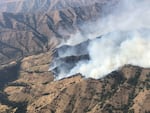Fire activity was significantly less on Sunday for the Double Creek Fire in northeast Oregon. Although temperatures were warm and relative humidity values were low, winds were much lighter than the previous day.
The boundary for a wildfire burning in Wallowa County covered nearly 44,000 acres with 0% containment as of a Monday morning report.
The Double Creek Fire is burning 10 miles southeast of Imnaha, a remote community in Oregon’s northeast corner. The area is under several evacuation levels, including “go now” evacuations.
The fire also prompted evacuations by campers from Imnaha south to Pallette Ranch, the Wallowah County Sheriff’s Office said. The fire, burning on conifer timber stands and grass and shrubs in the Hells Canyon Recreation Area, was detected on Aug. 30 and started by lightning.

In this photo provided by InciWeb, the Double Creek fire is seen on Saturday.
InciWeb
Gov. Kate Brown on Saturday invoked an emergency conflagration act in response to the fire. The declaration makes available more firefighters and other firefighting resources.
“With many fires actively burning across the state and several weeks of peak fire season ahead of us, I am urging all Oregonians to be prepared,” Brown said in a statement.
Firefighters are monitoring two other lightning-caused fires in the nearby Eagle Cap Wilderness. The Nebo Fire has charred about 7,000 acres of rugged terrain, while the Sturgill Fire had grown to 8,600 acres by Sunday morning. Crews were allowing the two fires to feed on dry fuels while protecting structures.
The Associated Press contributed to this report.